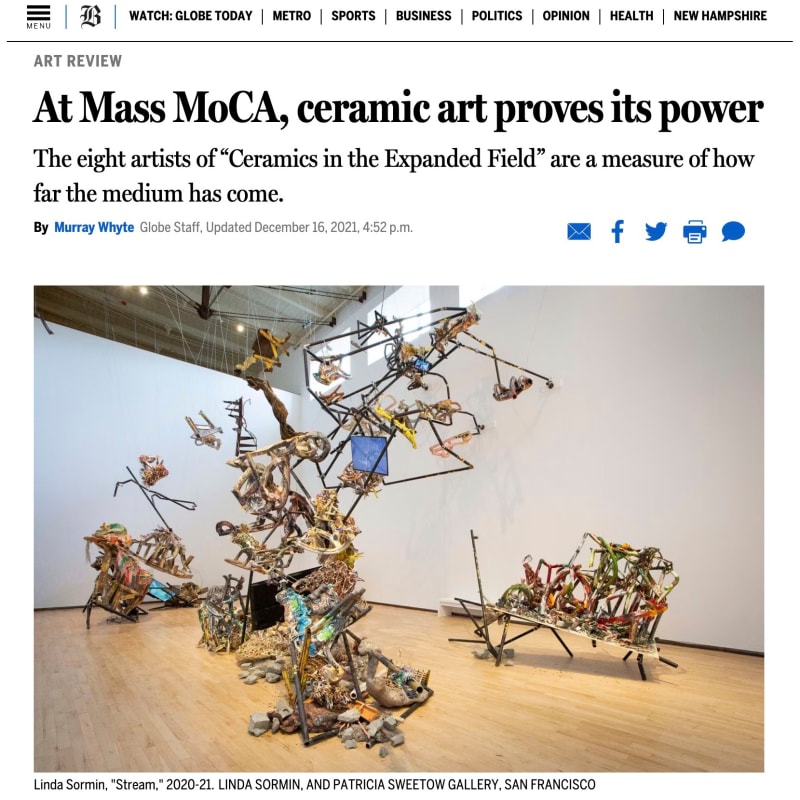The eight artists of “Ceramics in the Expanded Field” are a measure of how far the medium has come.
By Murray Whyte
NORTH ADAMS — What are the politics of pottery? That’s what a new exhibition at the Massachusetts Museum of Contemporary Art wants you to consider. “Ceramics in the Expanded Field” takes its name from a 1979 essay by the critic Rosalind Krauss, whose “expanded field” involved sculpture and its crossovers with other canonized creative fields like architecture. In the case of ceramics, a medium long excluded in the conversation of “serious” art, the expansion has necessarily been huge to take in a realm barely considered to be art at all just a couple of decades ago.
In this moment of radical inclusiveness — finally — those distinctions seem sort of silly, as though a medium could ever be a greater determinant of an artwork’s value than the ideas that drive it (it’s not). At Mass MoCA, Linda Sormin’s tangle of jagged sheet metal, video screens, iron pipe and vibrant clay and ceramic forms make a good case; it’s a chaotic amalgam of material and form so ragged and violent it looks like the aftermath of a natural disaster. I like what it’s saying: Tear it down, start again. The rules have changed.
In the art world, rules have always mattered a little too much. It’s a realm that historically loves boxes and categories, the better to put things in — and keep things out. Consider the rough ride photography got for the better part of a century — a copying device, the old argument went, could hardly be an instrument for art — and the relatively recent arrival of ceramics to art-world credibility feels like a blink.
But there’s an important distinction that makes the particulars clearer. New media like photography always have to get past just being new and need artists to embrace their creative potential to prove it. The same was true of video; and right now, the burgeoning field of digital art is still building its case for the many who still need convincing.
Ceramics have never had a comparable early-adopter syndrome; as a medium, it’s as old as the hills, or at least humankind. The prejudice against it was rooted less in its newness than the heavy historical freight it carried. Ceramics were decorative, or utilitarian, or women’s work, or ethnographic craft, and often all of the above, though any one of them made it easy to separate from exalted realms like painting.
Radical craft movements of the 1970s and ‘80s nudged the practice forward, usually with a self-conscious embrace of the medium’s negative stereotypes (“The Dinner Party,” Judy Chicago’s icon of the 1970s feminist art movement, not coincidentally featured custom ceramic place settings for an esteemed group of feminist heroes). Later breakthroughs helped: British ceramicist Grayson Perry won the 2003 Turner Prize, an annual award in Britain that tends to honor a British artist considered to be at the bleeding edge of contemporary thought.
So by now, the medium’s lowly status feels more a relic than a current concern. That makes “Ceramics in the Expanded Field” less a radical proposition than a measure of how far the field has come. Even so, to work with ceramics is to carry one or all of its many cultural burdens, which each of the eight artists here come by naturally: Of the eight, six are women, and of the two men, one is Mexican American and the other is Black. Their work is rich and diverse, but in almost every case, has marginalized histories baked in.
Linda Sormin’s frantic assemblage shares the biggest gallery here with work by Nicole Cherubini and Francesca DiMattio. Cherubini’s pieces are rough and glistening perversions of ceramic standards like vases and urns; in a sly nod to a radical pioneer of women’s work, she rims the lip of a red and white piece with a thatch of dark fur (in 1936, Surrealist icon Meret Oppenheim lined a spoon, saucer and teacup with fur and called it “Object”).
DiMattio makes broader connections, festooning her three towering roughshod totems with familiar patterns — one has pretty floral china motifs stretched over yellow quilted oven-mitt arms; another has Staffordshire-blue birds and fishes creeping across its shiny, bulbous skin. A towering teapot-headed piece is lacquered with what look like cancerous growths, bubbling and scaly; bits of trash ephemera are embedded in patches of its ceramic hide. She calls it “Teddy Bear Caryatid,” a collision of consumer culture and classical sculpture (a caryatid is a female form in ancient Greece used as an architectural support). The work is an explosion of formal exuberance shot through with feminist critique. It’s seductive, contrarian and sly, and maybe the best thing here.

